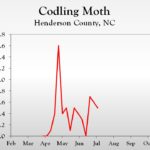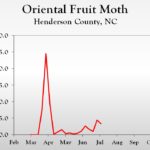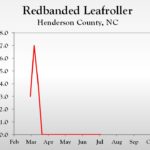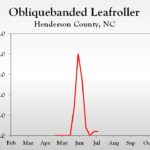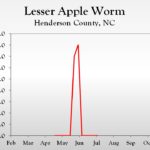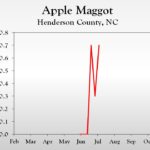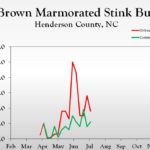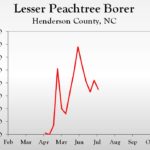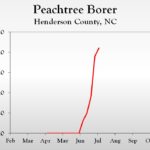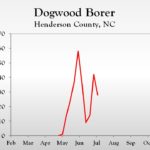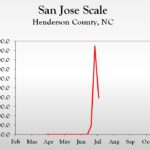WNC Orchard Insect Pest Populations – July 14, 2020
go.ncsu.edu/readext?710446
en Español / em Português
El inglés es el idioma de control de esta página. En la medida en que haya algún conflicto entre la traducción al inglés y la traducción, el inglés prevalece.
Al hacer clic en el enlace de traducción se activa un servicio de traducción gratuito para convertir la página al español. Al igual que con cualquier traducción por Internet, la conversión no es sensible al contexto y puede que no traduzca el texto en su significado original. NC State Extension no garantiza la exactitud del texto traducido. Por favor, tenga en cuenta que algunas aplicaciones y/o servicios pueden no funcionar como se espera cuando se traducen.
Português
Inglês é o idioma de controle desta página. Na medida que haja algum conflito entre o texto original em Inglês e a tradução, o Inglês prevalece.
Ao clicar no link de tradução, um serviço gratuito de tradução será ativado para converter a página para o Português. Como em qualquer tradução pela internet, a conversão não é sensivel ao contexto e pode não ocorrer a tradução para o significado orginal. O serviço de Extensão da Carolina do Norte (NC State Extension) não garante a exatidão do texto traduzido. Por favor, observe que algumas funções ou serviços podem não funcionar como esperado após a tradução.
English
English is the controlling language of this page. To the extent there is any conflict between the English text and the translation, English controls.
Clicking on the translation link activates a free translation service to convert the page to Spanish. As with any Internet translation, the conversion is not context-sensitive and may not translate the text to its original meaning. NC State Extension does not guarantee the accuracy of the translated text. Please note that some applications and/or services may not function as expected when translated.
Collapse ▲ Overall direct insect pest populations remain relatively low throughout the region, while populations of key secondary pests such as European red mite and leafhoppers are becoming more prevalent. In lower elevations of the piedmont, first generation brown marmorated stink bug will begin emerging later this week.
Overall direct insect pest populations remain relatively low throughout the region, while populations of key secondary pests such as European red mite and leafhoppers are becoming more prevalent. In lower elevations of the piedmont, first generation brown marmorated stink bug will begin emerging later this week.
Codling Moth
In lower elevations near Cleveland and Lincoln Counties, codling moth degree day accumulations average 1830 DD since biofix, which coincides with about 60% egg hatch of the second generation. If trap captures remain low and there is no evidence of damage, the potential for populations to flare up at this time are very low. In Henderson County at an elevation of about 2100 ft, cumulative DD since biofix are only about 1275. Emergence of second generation adults picks up between 1400-1450 DD, which is predicted to occur early next week. For those using mating disruption for codling moth and OFM, it is unlikely that insecticides are needed for this generation, although pheromone trap captures should be the determining factor.
Brown Marmorated Stink Bug
As shown in the figure below, first generation BMSB adult emergence is predicted to begin by the end of this week in the Cleveland/Lincoln County area (1,000 ft elevation). Emergence begins at about 700 DD (predicted in this area for July 18), and by July 21 predicted DD accumulations are 735, which coincides with emergence of about 7% of the population. Insecticide applications for BMSB (see below) should be considered next week in those areas with a history of BMB problems.
Emergence of first generation adults is still at least three weeks away in higher elevations (>2000 ft). Degree-day accumulations at the MHCREC in Henderson County (2080 ft) is only at 435 DD as of July 14, and is predicted to be 495 in a week.
Insecticides effective against BMSB include several neonicotinoids (Actara and Belay) and most pyrethroids (i.e., Brigade, Bifenture, Baythroid, Danitol, Warrior/Karate, Mustang Max, Tombstone). It should be noted that neither neonicotinoids or pyrethroids are recommended for codling moth, so in those orchards where both BMSB and codling moth are of concern, either a tank mix with one of the above materials plus an insecticide effective against codling moth, or the premixes Besiege (chlorantraniliprole + lambda-cyhalothrin) or Voliam Flexi (chlorantraniliprole + thiamethoxam). Where Altacor (chlorantraniliprole) was used for first generation codling moth control, the above-mentioned premixes should not be used.
While the approval of the Section 18 request for bifenthrin was in last week’s update, it should be noted that this year’s request for dinotefuran (Venom, Scorpion) on apples has not been approved by the EPA.
Learn more about southeastern apple insect pests at the Apple Insect Management page.
2020 Average Weekly Trap Captures
| HENDERSON COUNTY | |||
| Insects per trap | |||
| Jun 29 | Jul 6 | Jul 13 | |
| Codling moth | 0.7 | 0.6 | 0.5 |
| Oriental fruit moth | 1.0 | 4.4 | 3.3 |
| Tufted apple bud moth | 4.0 | 3.0 | 0.0 |
| Redbanded leafroller | 0.0 | 0.0 | 0.0 |
| Obliquebanded leafroller | 0.0 | 1.0 | 1.0 |
| Lesser appleworm | 0.0 | 0.0 | 0.0 |
| Apple maggot (abandoned and research orchards) | 0.7 | 0.3 | 0.7 |
| Brown marmorated stink bug (commercial) | 1.5 | 0.8 | 1.1 |
| Brown marmorated stink bug (unsprayed) | 1.9 | 2.8 | 1.8 |
| Spotted tentiform leafminer | 31.0 | 34.0 | 15.0 |
| Dogwood borer | 14.0 | 42.0 | 28.0 |
| Peachtree borer | 9.0 | 19.0 | 21.0 |
| Lesser peachtree borer | 33.0 | 42.0 | 35.0 |
| San Jose scale | 190.0 | 1895.0 | 785.0 |
*Note that these averages illustrate only the timing of insect emergence and fluctuations in populations, and are not representative of population levels in any given orchard. The only way to have an accurate assessment of an individual orchard’s populations is to set up traps in that orchard.
2020 Accumulated Degree Days
| HENDERSON COUNTY | ||||
| Jun 29 | Jul 6 | Jul 13 | ||
| Codling moth (Biofix 4/20) | 919 DD | 1088 DD | 1246 DD | |
| Oriental fruit moth (Biofix 3/30) | 1421 DD | 1626 DD | 1818 DD | |
| Tufted apple bud moth (Biofix 4/27) | 1163 DD | 1368 DD | 1560 DD | |




